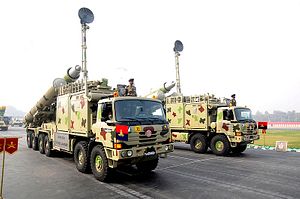The Indian Ministry of Defense’s (MoD) research arm, the Defense Research Development Organization (DRDO), and the Indian Army have test fired a supersonic BrahMos cruise missile fitted with an Indian-made seeker at the Pokhran test range in Rajasthan on March 22, the MoD said in a statement.
“The precision strike weapon with indigenous seeker flew in its designated trajectory and hit the pre-set target,” the statement reads. According to Indian defense minister, the BrahMos missile, fired from transporter erector launcher, “hit the target with pin-point accuracy.”
It was the first time a ground-launched BrahMos equipped with an indigenous seeker — developed by BrahMos Aerospace and DRDO, and manufactured by state-owned Electronics Corporation of India — was successfully tested. BrahMos missiles currently in service with the Indian military are fitted with Russian-supplied seekers for terminal guidance. However, India has been working for a couple of years on developing a new indigenous seeker that would eventually replace the Russian-made system as a result of contractual disputes between Moscow and New Delhi.
The BrahMos missile program is a joint venture between India’s DRDO and Russian rocket design bureau NPO Mashinostroyeniya. India supplies the BrahMos’ inertial navigation system and fire control system, and Russia the ramjet propulsion system and seeker. As a result of the successful March 22 test, future BrahMos missiles will now likely be fitted with the new Indian-made seeker. (India’s defense industry has also been working on other missile seeker technologies for the BrahMos missile, according to sources.)
The two-stage BrahMos missile — named after the Brahmaputra River in India and the Moskva River in Russia – is a derivative of the Russian P-800 Oniks over-the-horizon supersonic anti-ship cruise missile. The land-launched and sea-launched variants of the BrahMos are already in service with the Indian Army and Navy. An air-launched variant is expected to become operational by the end of 2018 with the Indian Air Force. As I reported previously:
The air-launched version is lighter (2.55 tons) than other variants and features additional rear fins for aerodynamic stability. The missile’s range is estimated at around 290 kilometers (180 miles). (…) With top speeds of Mach 2.8 to 3, the BrahMos is thought to be the world’s fastest cruise missile currently in service.
The IAF will retrofit up to 40 Sukhoi Su-30 MKI multirole air superiority fighters to carry and launch the air-launched BrahMos missile. The IAF is slated to test an extended-range (ER) air-launched variant of the missile, reportedly capable of hitting targets at a distance of up to 800 kilometers, by the end of 2018. (The ground-launched ER variant has already been tested last year.) As I speculated this January:
The new 800-kilometer range BrahMoS-ER could be an indication that India will deploy the BrahMos as part of the air component of its nuclear triad. Analysts believe that the BrahMos can be modified into a nuclear-capable missile. The Indian MoD until now has not publicly confirmed that it is seeking a nuclear capability for the supersonic cruise missile.
The last test firing of an air-launched BrahMos missile took place in December 2017.

































